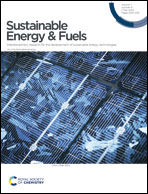Sustainable porous carbons from tannic acid based KOH activated as high-performance CO2 capture sorbents†
Abstract
A potentially viable strategy for the fabrication of efficient sorbents for CO2 capture is the use of porous carbons obtained from biomass, which have a large surface area and delicately organized porous structural framework. Herein, a series of porous carbons having enormous surface areas (as high as 2553 m2 g−1) and high micropore volumes (up to 0.8605 cm3 g−1) were fabricated from a renewable precursor, tannic acid. At a pressure of 1 bar, the porous carbons performed better at absorbing CO2; the respective maximal capacity was 7.03 and 4.29 mmol g−1 at 0 and 25 °C. The existence of a large number of narrow micropores with a pore width less than 0.86 nm and 0.70 nm plays a critical role in the CO2 uptake, respectively. Additionally, when tested against a mixture of CO2 and N2, TCKP-2-600 showed a good degree of selectivity for CO2 uptake as well as good recyclability. Additionally, the Langmuir, Freundlich, Toth isotherm and Redlich–Peterson models were employed to process and fit the experimental equilibrium values for the adsorption of CO2. All models accurately reflected the experimental data based on the standard deviation Δq (%) and regression coefficient (R2). This bioinspired precursor-synthesis technique is capable of generating porous carbons that are practically utilizable for a wide range of practical uses including CO2 absorption.

- This article is part of the themed collection: Sustainable Energy & Fuels Recent HOT Articles


 Please wait while we load your content...
Please wait while we load your content...